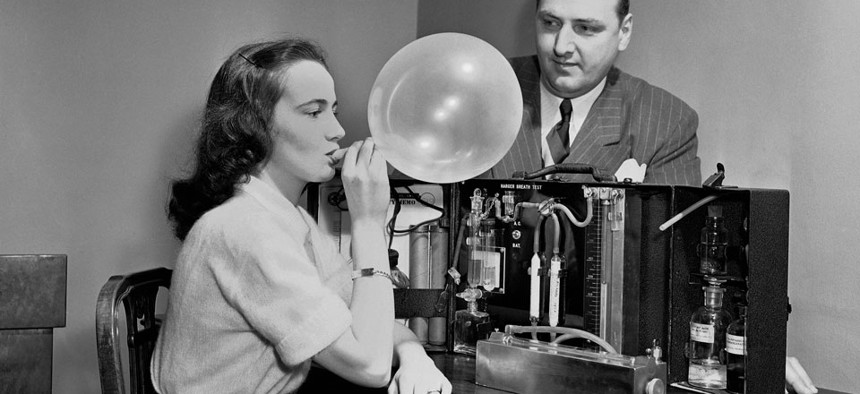A Breathalyzer That Can Diagnose Cancer

A breathalyzer prototype demonstrated in 1950. Carl Nesensohn/AP File Photo
Breathprints can give doctors information that patients won't or can't offer.
If a fingerprint can tell someone who you are, a "breathprint" could reveal how you're doing.
That's according to Raed Dweik , the doctor who runs the pulmonary vascular program at the Cleveland Clinic's Respiratory Institute .
For the past two decades, Dweik has been studying the molecular patterns in breath that can reveal what's happening inside the body. In the same way that a pocket of air above the water level in a closed container carries signature molecules that reflect the composition of that water, our breath is directly linked to what's happening in our blood.
"A lot of people just think breath is what's in your lungs," Dweik told me. "We realize now that anything in your body that is eventually in the blood can be measured in your breath."
That includes diseases like lung cancer, liver disease, heart disease, asthma, and inflammatory bowel disease, all of which have "really distinct signatures in the breath," Dweik says. And the medical implications are major: Breath-testing devices—think of them as Breathalyzers that detect disease rather than alcohol—can be just as accurate as traditional blood testing or biopsies, only cheaper and far less invasive.
Some breath-analysis devices highlight higher concentrations of certain molecules, as depicted in the image below:

Other breath tests show exactly which molecules are present, and at what levels, which enables doctors to better understand an individual's health while also learning more about the disease or condition he has.

Ideally, Dweik says, breath analysis would be incorporated into a testing approach that would include an array of diagnostic tools. "The advantage of breath testing is that it's noninvasive and nonintrusive," he said. "It can be done anyplace, anywhere, anytime." A breath test can also be repeated as many times as necessary, whereas other tests—X-rays for instance—are limited for safety reasons.
Not every disease has a discernible breath signature, though. Dweik couldn't find a distinctive breath pattern in patients with esophageal cancer, for instance. And yet some conditions that carry specific breathprints were unexpected. Dweik included obese patients in a control group before realizing that obesity carries a unique breathprint of its own.
"It shocked us," he said. "And this is why I started to think of breath as really way beyond the lungs...We now have to look at what processes in obesity make [people's] breath different. Is it that they metabolize food differently? It opens lots of questions."
While some recent breathprint discoveries are scientifically surprising, the overall findings are deeply intuitive. Western medicine's earliest ideas about wellness were directly tied to breath. Ancient Greeks may not have understood the mechanics of breathing, but they knew it was essential for life.
Today, researchers are trying to figure out whether someone who is concussed—a football player, for example—has a breath signature that might reflect his or her head injury. And though Dweik believes breath testing is the "next frontier" in medical diagnoses, technological advancements lag behind clinical ones. Some breath-analysis devices are still as big as washing machines, and require patients to visit the doctor to use them. (However, there are balloon-like breath-collection devices that can work for some patients who aren't well enough to travel.) Other devices are about the size of a landline telephone, but still have to be plugged into a power source, so they aren't fully portable.
The "Holy Grail of breath testing" would be a Breathalyzer-style device that a person could carry in her pocketbook and use any time, Dweik says. Manufacturers are already working on it. Vantage Health is using NASA technology to develop cancer-screening breath-test devices that could be attached to a smartphone and would relay data to an app.
These kinds of on-the-go screening devices could help a person monitor his health fro home, and figure out when it's time to go to the hospital—before a serious problem occurs. In the meantime, Dweik is continuing to identify breathprints for a variety of conditions. "The more we look into the breath," he said. "The more we find."


